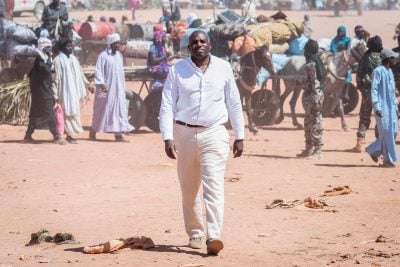This article was produced with the support of Shelter Afrique Development Bank
Shelter Afrique Development Bank has announced its intention to significantly reduce the affordable housing deficit in Africa. What are your targets?
Thierno-Habib Hann: Our goal is to finance nearly 200,000 affordable homes by 2030. This is supported by a mixed strategy: direct loans, private project financing, investments in innovative financial instruments, and technical assistance to governments.
Priority countries are identified based on several criteria: housing deficit, commitment of national authorities, macroeconomic stability, and regulatory environment.
The VIRAL model is your new analytical framework for achieving these objectives. How do you intend to apply it in practice?
The VIRAL model (Vision, Institutions, Regulations, Actors, Local Initiative) enables us to systematically assess national housing ecosystems. In the short term, our objective is to identify critical flaws in national systems, such as a lack of institutions, weak mortgage financing or regulatory barriers.
We also want to prioritise key reforms in each member country and propose concrete roadmaps with targeted technical support. The aim is to support countries towards the gradual maturation of their housing systems, with measurable indicators over three to five years.
What do you identify as the main challenge?
The lack of efficient institutions is often the biggest challenge. Many countries lack specialised agencies capable of steering complex housing policies or suffer from a lack of inter-sectoral coordination.
To address this, Shelter Afrique Development Bank offers institutional strengthening programmes including training, steering tools and digitalisation, assistance in setting up or modernising housing agencies and financing for pilot projects aimed at building local capacity.
Our approach aims to build resilient institutions that are rooted in their context and capable of bringing together public and private actors around housing policy.
How can Algeria’s experience in social housing serve as a reference for the continent?
Algeria has focused on public project management and the use of local resources (national labour and materials). Its experience can offer relevant lessons, particularly in the planning of large programmes, state financing and local industrial integration.
However, this experience must be analysed in context. Economic, social and institutional realities vary considerably from one country to another. Algeria can therefore contribute to the continental debate by sharing its successes as well as the challenges it has encountered, so that each country can adapt these lessons to its own priorities.
To what extent can the Algerian model inspire African housing finance?
The Algerian model relies on strong state involvement in housing production and subsidies. It shows that it is possible to mobilise public resources on a large scale to respond to a major social crisis.
However, this model must be analysed with discernment: it is neither transferable as it stands nor universally applicable. What is relevant is the example it provides of the role of the state as facilitator or guarantor, and the need for a solid institutional framework to manage complex programmes.
Other African countries can draw partial inspiration from it, while developing hybrid solutions adapted to their fiscal, demographic and land tenure realities.
Beyond this exchange of experiences, what concrete forms could collaboration between Shelter Afrique Development Bank and Algeria take?
It could take several forms: technical exchanges on housing finance and production systems, industrial partnerships in the manufacture or export of materials, and training programmes to strengthen the skills of the construction sector in other countries.
This is based on a logic of open regional cooperation, where each member country can contribute according to its strengths – with the common goal of structuring a more robust, autonomous and competitive African housing ecosystem.
Could this lead to the opening of a Shelter Afrique Development Bank office in Algeria?
Of course. Setting up regional offices is part of our strategic thinking to strengthen our presence on the ground. That said, the creation of an office will depend on several factors: projected demand in the region, the quality of local partnerships, logistical capabilities and potential impact.
The aim is not to have representation in every country, but to maximise the effectiveness of our regional interventions.
The 44th General Assembly is focusing on autonomy and sovereignty in the housing industry in Africa. What concrete initiatives would you like to see emerge from this edition in Algiers?
This Assembly is an opportunity to develop a continental declaration on sovereignty in housing, incorporating the challenges of local production, domestic financing and reducing dependence on imports.
We also want to see the launch of regional initiatives for the production of materials, via African industrial clusters, the promotion of quality and sustainability standards adapted to African realities, and a regional monitoring framework to measure the impact of reforms.
To finance this programme, Shelter Afrique Development Bank has recently broadened its vision with new financial instruments, including green bonds. How will these innovations transform access to housing?
These instruments respond to critical needs. Green bonds enable the financing of sustainable and energy-efficient housing, while attracting investors concerned about ESG (environmental, social and governance) criteria.
Mobilising resources in local currency avoids the exchange rate risks that often hinder projects and promotes long-term financing, which is better suited to housing. By combining financial innovation and social objectives, we aim to create a more inclusive, resilient and sustainable ecosystem for housing in Africa.
Algeria inspires the continent
During the Shelter Afrique AGM in Algiers, there was considerable admiration for the host country’s ability to locally produce almost all the materials needed for housing construction. Many delegates said they were inspired by the country and would use it as a benchmark for their own efforts.
This self-sufficiency now puts public and private operators in a position to export their know-how on a massive scale to the rest of Africa.
“The recommendations highlight the importance of replicating Algeria’s pioneering experience in housing and urban planning, adapting it to the specific characteristics of each country” said Réda Bouarioua, Director General of Construction at the Algerian Ministry of Housing.
The Algerian model is not limited to technical aspects. It owes as much to public commitment as to a clear political strategy. After visiting the National Agency for the Improvement and Development of Housing (AADL) site in Sidi Abdellah, Algiers, the Ivorian Minister Bruno Nabagné Koné said: “We are impressed by the quality of the construction, but even more so by the political determination behind this project. African countries aspiring to large-scale social housing programmes should take inspiration from this: it requires determination, resources and a clear vision.
“The emphasis on the extensive use of local materials is seen as a catalyst for job creation and cost reduction, two priorities for neighbouring economies. At the heart of this system, the lease-to-own formula – central to the Algerian scheme – is attractive for its flexibility and its ability to meet the common challenge of home ownership.”
Côte d’Ivoire, he said, intends to incorporate the lessons learned from Algeria’s experience in order to review its national policy in this area. The exchanges have stimulated the emergence of avenues for technical and commercial cooperation. The aim is no longer just to draw inspiration, but to also co-construct on the basis of a proven, exportable and adaptable model.
Demographic pressure on African markets only reinforces the urgency of such an approach. Africa faces a structural housing shortage estimated at 52m units.
Thierno-Habib Hann, CEO of Shelter Afrique Development Bank, said that the response to this crisis requires “more than $1 trillion in financing.”
In this context, the creation of an African centre of excellence for construction materials, bringing together Shelter Afrique Development Bank and Algeria is timely. The aim is to accelerate technology transfer, support the upgrading of national industries and enable the continent to address the issue of housing from the perspective of sovereignty.
Faced with the rapid growth of African cities, the focus on public-private partnerships, regulatory innovation and the mobilisation of regional and international investors reflect a desire to build an indigenous housing industry.

 Sign in with Google
Sign in with Google 



